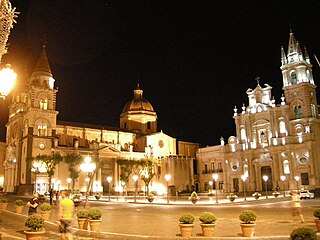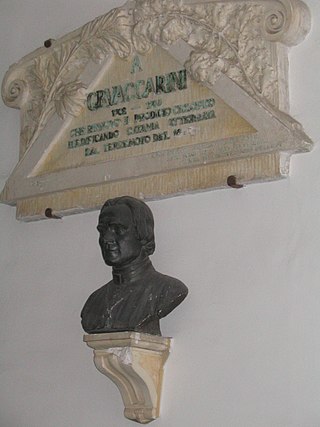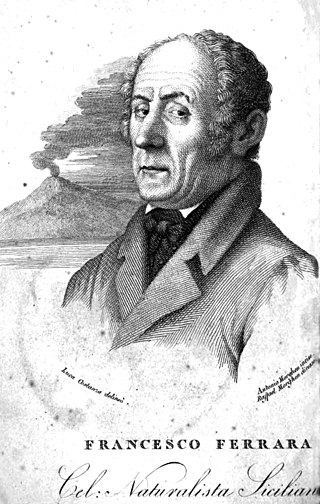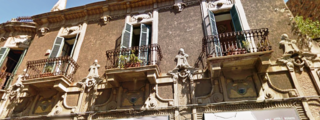History
In this period a building for training clerics existed adjacent to a Benedictine Monastery in this area, built against the medieval walls of Catania. [1]
In 1572, archbishop of Catania, Antonio Faraone, founded a formal seminary, which by 1614 was located in a building here, facing the Senatorial building located where the present Palazzo degli Elefanti rises. [2] The building was incorporated into the Porta Uzeda, which was an opening in the Walls of Charles V. The building was partially damaged during the 29 May 1647 revolt against Spanish authorities. [3]
Ultimately, this structure was razed by the 1693 earthquake that devastated the city. Reconstruction was soon begun under the architect Alonzo di Benedetto, and continued in 1757 by Francesco Battaglia. In 1757, the institution received a large endowment by Salvatore Ventimiglia, prince of Belmonte, and vicar general to Sicily, which allowed the seminary to grant professors of classical languages, theology, philosophy, mathematics and natural sciences as well as the addition of a publishing house.
During the 19th century, many of the buildings here were occupied by a military barracks, restricting the seminary to the Southern wing of the building. A third floor was added by architect Mario Di Stefano in 1866.
The seminary building suffered during the bombardments of World War II, prompting the construction of a new seminary at San Giovanni la Punta, completed on 15 August 1951. This building was acquired by the offices of the Comune, and used for offices of the mayoralty. Today it still houses the offices of the treasurer of the city, as well as the Museo diocesano di Catania (Museum of the Diocese).

Girolamo Rainaldi was an Italian architect who worked mainly in a conservative Mannerist style, often with collaborating architects. He was a successful competitor of Bernini. His son, Carlo Rainaldi, became an even more notable, more fully Baroque architect.

Grosseto is a comune in the central Italian region of Tuscany, the capital of the province of Grosseto. The city lies 14 kilometres from the Tyrrhenian Sea, in the Maremma, at the centre of an alluvial plain on the Ombrone river.

Acireale is a coastal city and comune in the north-east of the Metropolitan City of Catania, Sicily, southern Italy, at the foot of Mount Etna, on the coast facing the Ionian Sea. It is home to numerous churches, including the Neo-Gothic St. Pietro's Basilica, St. Sebastiano's Basilica in the Sicilian Baroque style, and the 17th century Acireale Cathedral, and a seminary, for the training of priests. Acireale is also noted for its art and paintings: the oldest academy in Sicily, the Accedemia di scienze, lettere e belle arti degli Zelanti e dei Dafnici, is located here.

Comacchio is a town and comune of Emilia Romagna, Italy, in the province of Ferrara, 48 kilometres (30 mi) from the provincial capital Ferrara. It was founded about two thousand years ago; across its history it was first governed by the Exarchate of Ravenna, then by the Duchy of Ferrara, and eventually returned to be part of the territories of the Papal States. For its landscape and its history, it is considered one of the major centres of the Po delta.

Giovanni Battista Vaccarini was a Sicilian architect, notable for his work in the Sicilian Baroque style in his homeland during the period of massive rebuilding following the earthquake of 1693. Many of his principal works can be found in the area in and around Catania.

Piazza dei Cavalieri is a landmark in Pisa, Italy, and the second main square of the city. This square was the political centre in medieval Pisa. After the middle of 16th century the square became the headquarters of the Order of the Knights of St. Stephen. Now it is a centre of education, being the main house of the Scuola Normale di Pisa, a higher learning institution part of the University.

Cosimo Morelli was an Italian architect, active throughout the Papal States in a Neoclassic style.

Palazzo degli Elefanti is a historical building in Catania, region of Sicily, southern Italy. It currently houses the city's Town Hall. In the past, the prior building was also known as the Palazzo Senatorio or Loggia Senatoria.

The Palazzo Biscari is a monumental private palace located on Via Museo Biscari in Catania, Sicily, southern Italy. The highly decorative interiors are open for guided tours, and used for social and cultural events.

The Palazzo Tezzano is a monumental palace in Piazza Stesicoro, in the center of Catania, Sicily, southern Italy. The via Etnea, with prominent shops, bisects the Piazza; this palazzo rises at the northwest intersection with this via, across from the white stone, neoclassical Palazzo Paterno del Toscano.

Giuseppe Sciuti was an Italian painter.
Piazza del Duomo is the main city square in Catania, Italy, flanked by both the centers of civic and religious power.

The following outline is provided as an overview of and topical guide to Palermo:

The Palazzo Alliata di Villafranca is former aristocratic mansion, now converted into a museum, located just off Via Vittorio Emanuele facing the Piazza Bologni which opens two blocks west of the Quattro Canti intersection, in the ancient quarter of the Albergaria of the city of Palermo, region of Sicily, Italy.

The Palazzo Gravina-Cruyllas is a palace located on the corner of Piazza San Francesco and Via Vittorio Emanuele, in the center of the city of Catania, Sicily, southern Italy. Vincenzo Bellini was born here, and the site now houses a museum dedicated to the opera composer: the Museo Civico Belliniano. The entrance stands across the piazza from the Monument to Blessed Giuseppe Dusmet and the church of San Francesco d'Assisi all'Immacolata.

The Palazzo dell'Università or Palazzo Centrale dell'Università di Catania is a monumental palace located in Piazza Universitaria, in the center of the city of Catania, region of Sicily, southern Italy. Since its construction, it has housed the main offices of the University of Catania, and stands across the piazza from the Palazzo San Giuliano, also housing offices of the university. It presently houses the offices of the rector, university offices, the "Giambattista Caruso" Regional Library, and a small museum of geology and archeology.

Francesco Ferrara was an Italian geologist, active mainly in Sicily, and known for his studies in vulcanology.

The palazzo Belimbau, also known as palazzo Antoniotto Cattaneo or Palazzo Francesco De Ferrari, is a building located in Piazza della Nunziata at number 2 in Genoa, included on 13 July 2006 in the list of the 42 palaces inscribed in the Rolli di Genova that became World Heritage by UNESCO on that date.



















